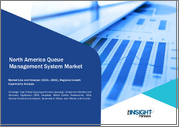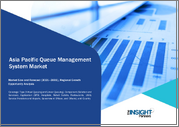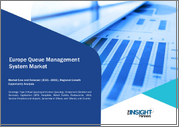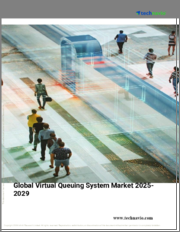
|
시장보고서
상품코드
1496139
세계의 큐 관리 시스템 시장 : 현황 분석 및 예측(2024-2032년)Queue Management System Market: Current Analysis and Forecast (2024-2032) |
||||||
큐 관리 시스템(Queue Management System) 시장은 특히 서비스 산업에서 고객 만족도 중시의 높아짐에 따라 CAGR 약 4.25%의 고성장이 전망되고 있습니다. 고객 만족도에 중점을 두는 것은 대기열 관리 시스템 수요를 홍보하는 중요한 요소입니다. 기업은 고객에게 원활한, 효율적이고 개인화된 경험을 제공하는 것이 중요하다는 것을 알고 있습니다. 대기열 관리 시스템을 통해 조직은 대기 시간을 최소화하고, 좌절감을 줄이고, 개인화된 상호작용을 제공할 수 있으며, 결국 고객 만족도를 높일 수 있습니다. 예를 들어 아메리칸 익스프레스가 실시한 조사에 따르면 고객의 86%가 더 나은 고객 경험을 위해서라면 더 많은 요금을 지불해도 상관없습니다고 생각하고 있는 것으로 나타났습니다. 또한 조직은 업무를 간소화하고 비용을 절감하며 자원 배분을 최적화하는 방법을 모색하고 있습니다. 대기열 관리 시스템은 대기 시간을 최소화하고 인건비를 줄이고 직원 생산성을 향상시켜 이러한 목표를 달성하는 데 도움이 됩니다. 또한 대기열 관리 시스템은 더 이상 의료 및 금융과 같은 전통적인 산업에 국한되지 않습니다. 조직이 효율적인 대기열 관리의 이점을 인식함에 따라 소매, 교육, 정부 등 다양한 분야에서 수요가 증가하고 있습니다. 마지막으로 큐 관리 시스템과 IoT, AI, 블록체인 등 신기술과의 통합으로 기능성, 효율성, 혁신성 강화를 위한 새로운 가능성이 열리고 있습니다. 이러한 요인은 환경을 촉진하고 다양한 산업에서 큐 관리 시스템의 보급에 영향을 미치고 있습니다.
컴포넌트에 따라 시장은 하드웨어, 소프트웨어 및 서비스로 구분됩니다. 세 가지 부문 모두 중요한 역할을 하지만 소프트웨어 부문은 큐 관리 시스템에서 가장 널리 채택된 컴포넌트로 부상하고 있습니다. 소프트웨어 컴포넌트는 대기열 관리 시스템의 백본으로, 기업이 고객 흐름을 관리하고, 대기 시간을 추적하며, 고객 행동을 분석할 수 있습니다. 소프트웨어 솔루션은 유연성, 확장성, 기존 시스템과의 통합의 용이성을 제공하며, 많은 기업에게 선호되는 옵션이 되었습니다. 이러한 소프트웨어 부문의 상승 궤도는 많은 요인에 기인합니다. 그 중 하나가 비용 효과적입니다. 소프트웨어 솔루션은 하드웨어 컴포넌트보다 비용 효율적인 경우가 많으며 비용이 많이 드는 하드웨어를 업그레이드하거나 교체할 필요가 없습니다. 또한 소프트웨어 솔루션은 CRM, ERP 및 기타 비즈니스 용도과 같은 기존 시스템과 원활하게 통합될 수 있으므로 모든 규모의 기업에 매력적인 제안이 됩니다. 마지막으로 소프트웨어 솔루션은 실시간 분석을 제공하므로 기업은 데이터를 기반으로 의사 결정을 내리고 업무를 최적화할 수 있습니다. 이들은 다양한 시장에서 큐 관리 시스템의 주요 부문으로서 소프트웨어 솔루션이 상승하는 요인의 일부입니다.
큐 유형에 따라 시장은 구조화된 큐, 비구조화된 큐, 키오스크 기반 큐, 모바일 큐로 분류됩니다. 오늘날의 마켓플레이스에서 큐 관리 시스템에 대한 수요의 대부분을 창출하는 것은 구조화된 큐의 부문입니다. 구조화된 큐는 고객이 서비스를 받기 위해 행렬에 정렬할 때 따라야 하는 미리 정의된 경로와 규칙을 수반합니다. 구조화된 큐는 큐 프로세스를 최적화하고 효율적인 서비스 제공을 보장하며 고객 대기 시간을 최소화하도록 설계되었습니다. 이는 은행, 관공서, 의료 시설, 소매점 등 대량의 고객을 다루는 비즈니스에 특히 중요합니다. 구조화된 대기열을 도입함으로써 이러한 조직은 업무를 간소화하고 고객 만족도를 높이고 생산성을 높일 수 있습니다. 또한 구조화된 큐에는 종종 가상 큐잉, 큐 관리 디스플레이, 자동 통화 시스템 등 기능이 내장되어 고객 경험을 크게 향상시킬 수 있습니다. 고객은 정확한 대기 시간 예측을 받고, 순서가 가까워지면 알림을 받거나, 원격 근무으로 대기열 위치를 예약할 수 있습니다. 이러한 편의성과 투명성의 높이는 고객 만족도의 향상에 공헌하고 충성도와 중계기를 키웁니다. 이러한 진보는 몇 가지 다른 진보와 함께 표준 대기열 부문의 지배에 기여하며 대기열 관리 시스템에 가장 큰 수익을 창출합니다.
배포별로 보면 시장은 클라우드 기반과 온프레미스로 이분됩니다. 큐 관리 시스템의 배포 모델로 가장 널리 사용되는 것은 클라우드 기반 솔루션입니다. 클라우드 기반 시스템은 비용이 많이 드는 하드웨어 설치, 유지보수 및 업그레이드가 필요 없기 때문에 특히 중소기업의 경우 비용 효율적입니다. 또한 클라우드 솔루션의 구독 기반 가격 모델은 더 나은 비용 예측 가능성과 확장성을 제공합니다. 또한 클라우드 기반 큐 관리 시스템은 복잡한 소프트웨어를 설치하거나 하드웨어를 구성할 필요 없이 빠르고 쉽게 배포할 수 있습니다. 서비스 제공업체가 업데이트 및 업그레이드를 수행하므로 조직의 IT 리소스 부담도 줄어듭니다. 또한 클라우드 기반 시스템은 인터넷 연결만으로도 어디서나 액세스할 수 있으므로 원격지에서 모니터링 및 관리할 수 있습니다. 이 기동성은 여러 기지와 분산된 직원이 있는 조직에 유리합니다. 클라우드 기반 서비스가 모든 규모의 기업에 매력적인 제안이 되려면 이러한 요인이 중요한 역할을 합니다.
용도별로 볼 때 시장은 보고서 분석, 약속 관리, 고객 서비스, 쿼리 처리, 상점 관리, 워크포스 최적화, 실시간 모니터링 및 기타(디지털 사이니지, 고객 참여)로 구분됩니다. 큐 관리 시스템이 세계에서 가장 널리 채택되는 부문은 고객 서비스와 매장 내 관리입니다. 고객 경험 향상 비즈니스의 주요 목표 중 하나는 탁월한 고객 경험을 제공하는 것입니다. 긴 대기 시간과 무질서한 대기열은 고객의 좌절로 이어져 만족도와 충성도에 악영향을 미칩니다.대기열 관리 시스템을 도입함으로써 기업은 대기열 프로세스를 간소화하고 대기 시간을 단축하며 고객에게 조직적이고 효율적인 경험을 제공할 수 있습니다. 또한 대기열 관리 시스템은 대기열 길이, 대기 시간 및 서비스 비율에 대한 실시간 데이터를 제공하여 운영 최적화를 지원합니다. 이 정보를 통해 기업은 피크 시간에 직원 배치를 조정하거나 서비스 카운터를 추가하는 등 리소스를 보다 효과적으로 할당할 수 있습니다. 비즈니스 효율성을 개선함으로써 기업은 비용을 절감하고 생산성을 높일 수 있습니다. 또한, 큐 관리 시스템은 종종 예약 스케줄링 및 고객 관계 관리(CRM) 플랫폼과 같은 다른 시스템과 통합될 수 있습니다. 이 통합을 통해 기업은 고객에게 원활하고 개인화된 서비스 경험을 제공할 수 있습니다. 예를 들어, 고객은 온라인으로 예약을 하고, 알림을 받고, 도착하는 대로 신속하게 서비스를 받을 수 있으므로, 대기 시간이 단축되고 전반적인 서비스 제공이 강화됩니다. 이러한 요인에 의해 큐 관리 시스템은 소비자 기업에게 필수적인 자산이 되어, 다양한 업계에서 큐 관리 시스템이 널리 채택되는 원동력이 되고 있습니다.
시장은 업종별로 은행, 교육, 레스토랑, 병원, 공공시설, 소매, 이벤트, 헬프 데스크, 공항, 차량 서비스 등으로 구분됩니다. 시장에서 병원과 의료 시설은 대기열 관리 시스템 수요의 대부분을 차지했습니다. 이 성장 궤도의 상승 경향은 환자 수가 많음 등 많은 요인에 기인하고 있습니다. 병원이나 의료 시설에서는 환자수가 많기 때문에 접수, 진단센터, 청구 카운터, 구급 부문 등, 다양한 서비스 포인트가 혼잡해, 장사의 열이 되는 경우가 자주 있습니다. 큐 관리 시스템은 병원이 환자의 흐름을 효과적으로 분배하고 병목 현상을 제거하여 자원을 효율적으로 사용할 수 있도록 합니다. 또한 대기열 관리 시스템은 대기 시간 단축, 실시간 대기열 업데이트, 모바일 체크인 및 예약 스케줄링과 같은 편의 시설을 제공하여 환자 경험을 향상시키는 데 기여합니다. 은행, 소매, 공항 등 다른 업계도 큐 관리 시스템을 널리 채택하고 있습니다만, 헬스케어 서비스의 섬세한 성질, 환자수가 많음, 복수의 서비스 포인트, 규제 준수 요건, 환자 체험에 주목 증가함에 따라 병원과 의료 시설은 큐 관리 시스템 수요를 세계적으로 견인하는 가장 지배적인 부문 중 하나가되었습니다.
큐 관리 시장 도입에 대한 이해를 높이기 위해 시장은 북미(미국, 캐나다, 기타 북미), 유럽(독일, 영국, 프랑스, 스페인, 이탈리아, 기타 유럽), 아시아 태평양(중국, 일본, 인도, 호주 및 기타 아시아 태평양), 세계 기타 지역에서 글로벌 존재를 기반으로 분석됩니다. 아시아 태평양은 대기열 관리 시스템의 거대한 시장 잠재력을 제시하고 생성된 수익의 대부분을 보유하고 있습니다. 주로 이 지역이 목격한 도시화의 동향으로부터 혜택을 받고 있습니다. 아시아 태평양은 급속한 도시화와 인구 증가를 목표로 하고 있으며, 소매, 헬스케어, 교통 등 다양한 분야에서 효율적인 큐 관리 솔루션에 대한 수요가 높아지고 있습니다.예를 들어, 유엔에 따르면 2050년까지 아시아 태평양의 인구의 64% 가까이 도시에 살게 됩니다. 이 도시로의 인구 유입은 고객 경험을 향상시키고 업무 효율성을 개선하기 위한 합리적인 대기열 관리 시스템 니즈를 증가시키고 있습니다. 또한 아시아 태평양에는 중국, 인도, 동남아시아 국가 등 세계에서 가장 크고 빠르게 성장하는 소매 및 전자상거래 시장이 있습니다. 예를 들어 아시아개발은행(ADB)이 발표한 보고서에 따르면 전자상거래는 세계 경제 국가에서 급속히 확대되고 있으며, 2019년에는 세계 GDP의 3.8%를 차지하고 2021년에는 5.4%로 증가 합니다. 2025년에는 6.4%를 나타낼 것으로 예측됩니다. 이러한 성장을 가속하는 요인으로는 스마트폰 이용, 온라인 쇼핑 편의성, 다양한 상품, 기술 진보 등이 있습니다. 아시아 태평양은 B2C 및 소매 전자상거래에서 선도하고 있으며 2025년까지 61% 시장 점유율을 차지할 것으로 예상됩니다. 아시아 태평양은 또한 모바일 앱, 클라우드 컴퓨팅, 인공지능(AI) 등 디지털 기술의 도입에서도 최첨단을 달리고 있습니다. 이 디지털 혁신은 이러한 기술을 활용하여 원활한 고객 경험을 제공하는 큐 관리 시스템을 도입하기 위한 길을 열고 있습니다. 예를 들어, 싱가포르, 한국, 일본 등 국가에서는 모바일 기반 큐 관리 솔루션이 인기를 얻고 있습니다. 아시아 태평양의 많은 정부는 스마트 시티 개발을 적극적으로 추진하고 공공 서비스를 강화하기 위한 이니셔티브를 실시했습니다. 큐 관리 시스템은 헬스케어, 교통기관, 관공청 등 다양한 분야에서 서비스 제공을 최적화하고 시민의 체험을 향상시킴으로써 이러한 대처에서 중요한 역할을 하고 있습니다. 특히 이러한 움직임은 아시아 태평양에서 큐 관리 시스템의 보급에 영향을 미치고 촉진 환경을 키우고 있습니다.
목차
제1장 시장 소개
- 시장 정의
- 주요 목표
- 이해관계자
- 제한 사항
제2장 조사 방법 및 전제조건
- 조사 과정
- 조사 방법
- 응답자 프로파일
제3장 주요 요약
- 업계 요약
- 부문별 전망
- 시장 성장 강도
- 지역 전망
제4장 시장 역학
- 성장 촉진요인
- 기회
- 억제요인
- 동향
- PESTEL 분석
- 수요측 분석
- 공급측 분석
- 합병과 인수
- 투자 시나리오
- 업계 인사이트 : 대기업 스타트업 기업과 그 독자적인 전략
제5장 가격 분석
- 지역별 가격 분석
- 가격에 영향을 미치는 요인
제6장 세계의 큐 관리 시스템 시장 매출(2022-2032년)
제7장 컴포넌트별 시장 분석
- 하드웨어
- 소프트웨어
- 서비스
제8장 큐 유형별 시장 분석
- 구조화 큐
- 비구조화 큐
- 키오스크 베이스
- 모바일 큐
제9장 전개별 시장 분석
- 클라우드 기반
- 온프레미스
제10장 용도별 시장 분석
- 보고서 애널리틱스
- 약속 관리
- 고객 서비스
- 쿼리 처리
- 점포 관리
- 노동력 최적화
- 실시간 감시
- 기타(디지털 사이니지, 고객 참여)
제11장 업종별 시장 분석
- 뱅킹
- 교육
- 레스토랑
- 병원
- 공공
- 소매
- 이벤트
- 헬프 데스크
- 공항
- 차량 정비
- 기타(운송, 유원지 등)
제12장 지역별 시장 분석
- 북미
- 미국
- 캐나다
- 기타 북미
- 유럽
- 독일
- 영국
- 프랑스
- 이탈리아
- 스페인
- 기타 유럽
- 아시아 태평양
- 중국
- 일본
- 인도
- 호주
- 기타 아시아 태평양
- 세계의 기타 지역
제13장 밸류체인 분석
- 한계 분석
- 시장 진출기업 일람
제14장 경쟁 구도
- 경쟁 대시보드
- 경쟁 시장 포지셔닝 분석
- Porter's Five Forces 분석
제15장 기업 프로파일
- Qwaiting.com
- Q-Matic AB
- wavetec
- VirtuaQ
- SEDCO
- Addsoft Technologies Private Limited
- Link Retail
- Isarsoft GmbH
- Advantech Co., Ltd
- Verint Systems Inc.
제16장 약어와 전제조건
제17장 부록
LYJA queue management system is a software application designed to manage and organize customer queues or waiting lines in various service environments, such as banks, hospitals, government offices, and retail stores. The primary goal of a queue management system is to enhance the customer experience by streamlining the waiting process and reducing perceived wait times.
The Queue Management System Market is expected to grow at a strong CAGR of around 4.25%, owing to the growing focus on customer satisfaction, particularly in the services industry. The growing emphasis on customer satisfaction is a significant factor driving the demand for queue management systems. Businesses are recognizing the importance of providing seamless, efficient, and personalized experiences to their customers. Queue management systems enable organizations to minimize wait times, reduce frustration, and offer personalized interactions, ultimately enhancing customer satisfaction. For instance, the study done by American Express found that 86% of customers are willing to pay more for a better customer experience. Furthermore, organizations are seeking ways to streamline their operations, reduce costs, and optimize resource allocation. Queue management systems help achieve these goals by minimizing wait times, reducing labor costs, and improving staff productivity. Additionally, Queue management systems are no longer limited to traditional industries like healthcare and finance. The demand is growing across various sectors, including retail, education, and government, as organizations recognize the benefits of efficient queue management. Lastly, the integration of queue management systems with emerging technologies like IoT, AI, and blockchain is opening up new possibilities for enhanced functionality, efficiency, and innovation. Factors such as these are fostering a conducive environment, influencing the widespread adoption of Queue management systems across various industries.
Based on components, the market is segmented into hardware, software, and service. While all three segments play a crucial role, the software segment has emerged as the most widely adopted component in queue management systems. The software component is the backbone of a queue management system, enabling businesses to manage customer flow, track wait times, and analyze customer behavior. Software solutions offer flexibility, scalability, and ease of integration with existing systems, making them a preferred choice for many businesses. This upward trajectory of the software segment can be attributed to a multitude of factors. One such factor is cost-effectiveness. Software solutions are often more cost-effective than hardware components, eliminating the need for expensive hardware upgrades or replacements. Furthermore, software solutions can be seamlessly integrated with existing systems, such as CRM, ERP, and other business applications, making it an attractive proposition for businesses of all sizes. Lastly, software solutions provide real-time analytics, enabling businesses to make data-driven decisions and optimize their operations. These are some of the factors leading to the emergence of software solutions as a predominant segment of queue management systems across various markets.
Based on queue type, the market is categorized into structured queues, unstructured queues, kiosk-based, and mobile queues. The structured queue segment generates the major portion of demand for queue management systems in today's marketplace. Structured queues involve predefined paths and rules for customers to follow when waiting in line for service. Structured queues are designed to optimize the queuing process, ensuring efficient service delivery and minimizing customer wait times. This is particularly crucial for businesses that deal with high customer volumes, such as banks, government offices, healthcare facilities, and retail stores. By implementing structured queues, these organizations can streamline their operations, improve customer satisfaction, and increase productivity. Furthermore, structured queues often incorporate features like virtual queuing, queue management displays, and automated call systems, which significantly enhance the customer experience. Customers can receive accurate wait time estimates, receive notifications when their turn is approaching, and even reserve their place in the queue remotely. This level of convenience and transparency contributes to higher customer satisfaction rates, fostering loyalty and repeat business. These advancements, along with some others, have contributed to this dominion of the standard queue segment, generating maximum revenue for the queue management system.
Based on deployment, the market is bifurcated into cloud-based and on-premise. The most widely adopted deployment model for queue management systems is cloud-based solutions. Cloud-based systems eliminate the need for expensive hardware installations, maintenance, and upgrades, making them more cost-effective, especially for small and medium-sized businesses. The subscription-based pricing model of cloud solutions also offers better cost predictability and scalability. Furthermore, cloud-based queue management systems can be deployed quickly and easily without the need for complex software installations or hardware configurations. Updates and upgrades are handled by the service provider, reducing the burden on the organization's IT resources. Additionally, cloud-based systems can be accessed from anywhere with an internet connection, enabling remote monitoring and management. This mobility is advantageous for organizations with multiple locations or a distributed workforce. Factors such as these have played a key role in making cloud-based services an attractive proposition for businesses of all sizes.
Based on application, the market is segmented into reporting & analytics, appointment management, customer service, query handling, in-store management, workforce optimization, real-time monitoring, and others (digital signage and customer engagement). The most widely adopted segment for queue management systems worldwide is customer service and in-store management. Improving Customer Experience One of the primary goals of businesses is to provide an exceptional customer experience, and queue management systems play a crucial role in achieving this. Long waiting times and disorganized queues can lead to customer frustration, negatively impacting satisfaction and loyalty. By implementing a queue management system, businesses can streamline the queuing process, reduce wait times, and offer a more organized and efficient experience for customers. Furthermore, Queue management systems help optimize operations by providing real-time data on queue lengths, wait times, and service rates. This information allows businesses to allocate resources more effectively, such as adjusting staffing levels or opening additional service counters during peak periods. By improving operational efficiency, businesses can reduce costs and increase productivity. Additionally, Queue management systems often integrate with other systems, such as appointment scheduling and customer relationship management (CRM) platforms. This integration allows businesses to provide a seamless and personalized service experience for customers. For example, customers can book appointments online, receive reminders, and be served promptly upon arrival, reducing wait times and enhancing the overall service delivery. Factors such as these have made the Queue management systems an indispensable asset for consumer-facing companies, driving the widespread adoption of Queue management systems across various industries.
Based on verticals, the market is segmented into banking, educational, restaurants, hospitals, public, retail, events, help desks, airports, vehicle servicing, and others. Hospitals and healthcare facilities create the major portion of the demand for Queue management systems in the global markets. This uptrend in growth trajectory can be attributed to a multitude of factors, such as high patient volumes. Hospitals and healthcare facilities often experience high patient volumes, leading to overcrowding and long queues at various service points like registration desks, diagnostic centers, billing counters, and emergency departments. Queue management systems help hospitals distribute patient flow effectively, reducing bottlenecks and ensuring efficient resource utilization. Furthermore, Queue management systems contribute to improved patient experiences by reducing wait times, providing real-time queue updates, and offering amenities like mobile check-in and appointment scheduling. While other industries like banking, retail, and airports also widely adopt queue management systems, the sensitive nature of healthcare services, high patient volumes, multiple service points, regulatory compliance requirements, and the increasing focus on patient experience make hospitals and healthcare facilities one of the most dominant segments driving the demand for queue management systems worldwide
For a better understanding of the market adoption of Queue management, the market is analyzed based on its worldwide presence in countries such as North America (The U.S., Canada, and the Rest of North America), Europe (Germany, The U.K., France, Spain, Italy, Rest of Europe), Asia-Pacific (China, Japan, India, Australia, Rest of Asia-Pacific), Rest of World. The Asia-Pacific region presents a huge market potential for queue management systems and holds most of the generated revenue. Primarily benefitted from the urbanization trend witnessed by the region. The Asia-Pacific region is witnessing rapid urbanization and population growth, leading to an increased demand for efficient queue management solutions in various sectors, such as retail, healthcare, and transportation. For instance, According to the United Nations, by 2050, nearly 64% of the Asia-Pacific population will live in urban areas. This urban population influx is driving the need for streamlined queue management systems to enhance customer experiences and improve operational efficiencies. Furthermore, The Asia-Pacific region is home to some of the world's largest and fastest-growing retail and e-commerce markets, such as China, India, and Southeast Asian countries. For instance, as per report published by the Asian Development Bank (ADB), E-commerce is rapidly expanding in the global economy, with it representing 3.8% of the global GDP in 2019 and increasing to 5.4% in 2021. Projections suggest it will reach 6.4% by 2025. Factors driving this growth include the use of smartphones, the convenience of online shopping, a variety of products, and technological advancements. The Asia-Pacific region leads in B2C and retail e-commerce and is expected to hold a 61% market share by 2025. The Asia-Pacific region has also been at the forefront of adopting digital technologies, such as mobile apps, cloud computing, and artificial intelligence (AI). This digital transformation has paved the way for the adoption of queue management systems that leverage these technologies to provide seamless customer experiences. For instance, mobile-based queue management solutions are gaining popularity in countries like Singapore, South Korea, and Japan. Government initiatives and smart city projects: Many governments in the Asia-Pacific region are actively promoting the development of smart cities and implementing initiatives to enhance public services. Queue management systems play a crucial role in these initiatives by optimizing service delivery and improving citizen experiences in various sectors, such as healthcare, transportation, and government offices. These developments among others are fostering a conducive environment, influencing the widespread adoption of Queue management systems in the Asia Pacific region.
Some of the major players operating in the market include Qwaiting.com; Q-Matic AB; wavetec; VirtuaQ; SEDCO; Addsoft Technologies Private Limited; Link Retail; Isarsoft GmbH; Advantech Co., Ltd; and Verint Systems Inc.
TABLE OF CONTENTS
1.MARKET INTRODUCTION
- 1.1. Market Definitions
- 1.2. Main Objective
- 1.3. Stakeholders
- 1.4. Limitation
2.RESEARCH METHODOLOGY OR ASSUMPTION
- 2.1. Research Process of the Queue Management System Market
- 2.2. Research Methodology of the Queue Management System Market
- 2.3. Respondent Profile
3.EXECUTIVE SUMMARY
- 3.1. Industry Synopsis
- 3.2. Segmental Outlook
- 3.3. Market Growth Intensity
- 3.4. Regional Outlook
4.MARKET DYNAMICS
- 4.1. Drivers
- 4.2. Opportunity
- 4.3. Restraints
- 4.4. Trends
- 4.5. PESTEL Analysis
- 4.6. Demand Side Analysis
- 4.7. Supply Side Analysis
- 4.7.1. Merger & Acquisition
- 4.7.2. Investment Scenario
- 4.7.3. Industry Insights: Leading Startups and Their Unique Strategies
5.PRICING ANALYSIS
- 5.1. Regional Pricing Analysis
- 5.2. Price Influencing Factors
6.GLOBAL QUEUE MANAGEMENT SYSTEM MARKET REVENUE (USD MN), 2022-2032F
7.MARKET INSIGHTS BY COMPONENT
- 7.1. Hardware
- 7.2. Software
- 7.3. Service
8.MARKET INSIGHTS BY QUEUE TYPE
- 8.1. Structured Queue
- 8.2. Unstructured Queue
- 8.3. Kiosk Based
- 8.4. Mobile Queues
9.MARKET INSIGHTS BY DEPLOYMENT
- 9.1. Cloud Based
- 9.2. On-Premise
10.MARKET INSIGHTS BY APPLICATION
- 10.1. Reporting & Analytics
- 10.2. Appointment Management
- 10.3. Customer Service
- 10.4. Query Handling
- 10.5. In-Store Management
- 10.6. Workforce Optimization
- 10.7. Real-Time Monitoring
- 10.8. Others (Digital Signage, and Customer Engagement)
11.MARKET INSIGHTS BY VERTICAL
- 11.1. Banking
- 11.2. Educational
- 11.3. Restaurants
- 11.4. Hospitals
- 11.5. Public
- 11.6. Retail
- 11.7. Events
- 11.8. Help Desks
- 11.9. Airports
- 11.10. Vehicle Servicing
- 11.11. Others (Transportation, Amusement Parks, etc.)
12.MARKET INSIGHTS BY REGION
- 12.1. North America
- 12.1.1. U.S.
- 12.1.2. Canada
- 12.1.3. Rest of North America
- 12.2. Europe
- 12.2.1. Germany
- 12.2.2. U.K.
- 12.2.3. France
- 12.2.4. Italy
- 12.2.5. Spain
- 12.2.6. Rest of Europe
- 12.3. Asia-Pacific
- 12.3.1. China
- 12.3.2. Japan
- 12.3.3. India
- 12.3.4. Australia
- 12.3.5. Rest of Asia-Pacific
- 12.4. Rest of World
13.VALUE CHAIN ANALYSIS
- 13.1. Marginal Analysis
- 13.2. List of Market Participants
14.COMPETITIVE LANDSCAPE
- 14.1. Competition Dashboard
- 14.2. Competitor Market Positioning Analysis
- 14.3. Porter Five Forces Analysis
15.COMPANY PROFILED
- 15.1. Qwaiting.com
- 15.1.1. Company Overview
- 15.1.2. Key Financials
- 15.1.3. SWOT Analysis
- 15.1.4. Product Portfolio
- 15.1.5. Recent Developments
- 15.2. Q-Matic AB
- 15.3. wavetec
- 15.4. VirtuaQ
- 15.5. SEDCO
- 15.6. Addsoft Technologies Private Limited
- 15.7. Link Retail
- 15.8. Isarsoft GmbH
- 15.9. Advantech Co., Ltd
- 15.10. Verint Systems Inc.



















